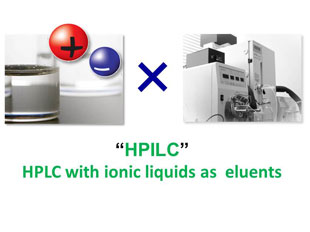イオン液体を用いたバイオリファイナリー

メンバー: 大野弘幸
分野: 複合化学、材料化学、材料工学
所属: 工学研究院
キーワード: イオン液体、植物バイオマス、ionic liquids、plant biomass、biorefinery
ウェブサイト:
研究概要

セルロースは地球上に豊富に存在する再生可能資源でありながら、一般的な溶媒に溶けにくいためにその利用が制限されています。我々は、このセルロースを温和な条件下で溶かす“イオン液体”を開発しています。イオン液体とは、プラス、マイナスの電荷を持つ分子のみからなる液体(水がないにも関わらず液体となる塩)です。検討の結果、カルボン酸や亜リン酸アニオンを有する高極性イオン液体が非加熱でセルロースを溶かすことを見出し(図1) [1]、小麦外皮からセルロースなどの多糖類成分を抽出することにも成功しました。また、水存在下ではセルロース溶解能がなくなるというイオン液体の致命的な弱点を克服した溶媒も開発し、濡れた木材からでもセルロースを取り出すことに成功しました[2]。
また、セルロース溶解以外に新たな機能を付与したイオン液体の開発も行っています。例えば、「疎水性かつ高極性」という一見相反する特性を有するイオン液体の開発にも成功しています[3]。また、多糖類以外の有用成分の回収にも挑戦しており、含塩湿潤状態の藻体から生分解性プラスチックpoly(3-hydroxybutyrate)を抽出することに成功しました[4]。
解析分野にも力を入れており、イオン液体を移動相や溶媒とするHPLCシステムやNMR測定へ展開させ、従来は調べることのできなかったセルロースの物性や相互作用などを明らかとしています[5](図2)。
主要論文・参考事項
[1]Y. Fukaya, K. Hayashi, M. Wada and H. Ohno, Green Chemistry, 2008, 10, 44.
[2]M. Abe, T. Yamada and H. Ohno, RSC Advances, in press.
[3]Y. Fukaya and H. Ohno, Physical Chemistry Chemical Physics, 2013, 15, 4066.
[4]K. Fujita, D. Kobayashi, N. Nakamura and H. Ohno, Enzyme and Microbial Technology, 2013, 52, 199.
[5]Y. Fukaya, A. Tsukamoto, K. Kuroda and H. Ohno, Chemical Communications, 2011, 47, 1994.
お問い合わせ先
東京農工大学・先端産学連携研究推進センター
urac[at]ml.tuat.ac.jp([at]を@に変換してください)
Biorefinery with Ionic Liquids

Research members: Hiroyuki Ohno PhD.
Research fields: Applied chemistry, Materials chemistry, Material engineering
Departments: Institute of Engineering
Keywords: onic liquids,plant biomass,biorefinery
Web site:
Summary

We have developed novel polar ionic liquids (ILs) which dissolves cellulose under mild conditions (Figure 1).[1] In addition, they extract cellulose from plant biomass under mild condition. As the latest result, tetrabutylphosphonium hydroxide (TBPH) aqueous solution was found to be an excellent solvent for cellulose. Since it dissolves cellulose in the presence of a certain amount of water, resulting in biomass processing of “wet” biomass.[2]
We also have prepared ILs having contradicting properties such as high polarity and hydrophobicity.[3] They have a potential to provide novel and powerful process for biomass treatment.
ILs are very useful for extraction of not only polysaccharides but also other biopolymers such as bioplastic. We succeeded to collect poly(3-hydroxybutyrate) from wet micro algae with the aid of ILs.[4]
Development of analytical methodologies of cellulose in polar ILs is also very important. We successfully applied polar ILs into HPLC as mobile phase by designing low viscous polar IL, called “HPILC” (Figure 2).[5] This HPILC clarifies molecular weight distribution of many kinds of cellulose which enables us to conduct direct analysis of cellulose depolymerization in polar ILs.
Reference articles and patents
[1]Y. Fukaya, K. Hayashi, M. Wada and H. Ohno, Green Chemistry, 2008, 10, 44.
[2]M. Abe, T. Yamada and H. Ohno, RSC Advances, in press.
[3]Y. Fukaya and H. Ohno, Physical Chemistry Chemical Physics, 2013, 15, 4066.
[4]K. Fujita, D. Kobayashi, N. Nakamura and H. Ohno, Enzyme and Microbial Technology, 2013, 52, 199.
[5]Y. Fukaya, A. Tsukamoto, K. Kuroda and H. Ohno, Chemical Communications, 2011, 47, 1994.
Contact
University Research Administration Center(URAC),
Tokyo University of Agriculture and Technology
urac[at]ml.tuat.ac.jp
(Please replace [at] with @.)
